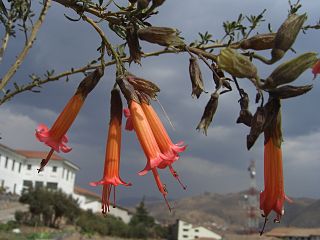
The Solanales are an order of flowering plants, included in the asterid group of dicotyledons. Some older sources used the name Polemoniales for this order.

Cantua Creek is a census-designated place (CDP) in Fresno County, California, United States. As of the 2010 census, the population was 466, down from the 655 reported at the 2000 census. Cantua Creek is located 11 miles (18 km) south-southwest of Tranquillity, at an elevation of 295 feet.

A forb or phorb is a herbaceous flowering plant that is not a graminoid. The term is used in biology and in vegetation ecology, especially in relation to grasslands and understory. Typically these are dicots without woody stems.

The Polemoniaceae are a family of flowering plants consisting of about 25 genera with 270–400 species of annuals and perennials native to the Northern Hemisphere and South America, with the center of diversity in western North America.

Cantua buxifolia,, known as qantu, qantus or qantuta (Quechua,) is a flowering plant found in the high valleys of the Yungas of the Andes mountains in western South America. Also known as the Peruvian magic tree, it is an evergreen shrub growing to 4 m (13 ft) tall by 2.5 m (8.2 ft) wide with small leaves and clusters of brilliant pink, narrow tubular flowers in early spring.

Ipomopsis aggregata is a species of biennial flowering plant in the phlox family (Polemoniaceae), commonly known as scarlet trumpet, scarlet gilia, or skyrocket because of its scarlet red flowers with lobes curving back as if blown back by rocketing through the air.

Suni or Jalca is one of the eight Natural Regions of Peru. It is located in the Andes at an altitude between 3,500 and 4,000 metres above sea level. Suni has a dry and cold weather and there are many glacial valleys.

Collomia is a genus of flowering plants in the family Polemoniaceae. Species in the genus are known generally as trumpets, mountain trumpets, or trumpet flowers. They are native to North America and southern South America. The genus name comes from the Greek kolla ("glue"), a reference to the seeds, which become gelatinous in texture when wet.

Gilia is a genus of between 25 and 50 species of flowering plants in the Polemoniaceae family and is related to phlox. These Western native plants are best sown in sunny, well-draining soil in the temperate and tropical regions of the Americas, where they occur mainly in desert or semi-desert habitats

Cobaeoideae is a subfamily of the Polemoniaceae family of flowering plants. It is native to Baja California and tropical parts of the Americas.

Cantua is a genus of flowering plants in the family Polemoniaceae which is in the order Ericales. They are restricted to central South America where many species are endemics in the countries of occurrence.

Microsteris is a monotypic genus of flowering plants in the phlox family containing the single species Microsteris gracilis, known by the common name slender phlox.

Acanthogilia is a genus with a single species of desert shrub from Baja California, Mexico. It was first scientifically described as a genus in 1986.
Rancho San Luisito was a 4,389-acre (17.76 km2) Mexican land grant in present day San Luis Obispo County, California given in 1841 by Governor Juan B. Alvarado to José de Guadalupe Cantúa. The grant between Morro Bay and San Luis Obispo, extended along San Luisito Creek and Chorro Creek and encompassed Hollister Peak.
Cantua Creek, formerly in Spanish Arroyo de Cantúa, was named for José de Guadalupe Cantúa, a prominent Californio Ranchero in the 19th-century Mexican era of Alta California.

Saltugilia is a genus of flowering plants in the phlox family, Polemoniaceae. They are known commonly as woodland gilias. There are four species. Two are endemic to California in the United States, and the distributions of the other two extend into Baja California in Mexico.

Ardisia escallonioides, the Island marlberry, is a plant species native to the West Indies and neighboring areas. It has been reported from Barbados, Bermuda, the Dominican Republic, Cuba, Mexico, Belize, Guatemala and Florida.
Ernst Huth was a German naturalist and botanist.
Bonplandia is a genus of flowering plants belonging to the family Polemoniaceae.















